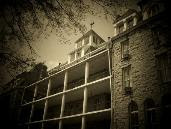 |
| Edited Photo of Claude Neal Lynching |
The U.S. Department of Justice has opened a new investigation into the notorious 1934 lynching of Claude Neal near Marianna, Florida.
FBI agents have been looking at archival records and interviewing family members of Neal as well as public officials in Jackson County, where the lynching took place. The Justice Department neither confirms nor denies such investigations, but has said that it is looking into nearly 100 such cases as part of a new focus on unsolved crimes of the Civil Rights era. Officials in Marianna, speaking off the record, confirmed that they have talked with the FBI about the case.
Claude Neal was a 23 year old black farm laborer in Jackson County at the time of the lynching. The series of events leading to his death began on October 18, 1934, when a 19 year old woman named Lola Cannady left her home in a rural area and walked a few hundred yards across an open field to water her family's hogs. She never came back.
 |
| Location of Lola Cannady Murder, 1980s |
As concern over her disappearance grew, family members and neighbors started to search the surrounding fields and woods. Near the hand pump at the hog pen they found indications of a large fight. Footprints went around and around in circles and there were blood splatters on the ground. They also found a man's footprints leading from the scene across a field to a nearby home.
When they followed the prints to the house, they found two women - Sallie and Annie Smith - trying to wash blood from a man's clothes. Annie's son, Claude Neal, was not home and would not return home that night. A bloody hammer was also found at the house. The women would soon admit that the clothes belonged to Neal and Annie Smith would tell Sheriff W.F. "Flake" Chambliss that she had seen Neal and Cannady near the hog pen and had heard her screams.
 |
| Lola's mother looking at her daughter's body, 1934. |
Lola's body was found in a wooded area the next morning. She had been raped and beaten to death. A blood-stained piece of cloth was found near her body. It matched a piece that had been torn from the sleeve of Claude Neal's shirt. Searchers also found the stem and loop of a pocket watch at the scene. When he was arrested that day, Neal was carrying a pocket watch but deputies quickly noted that it was missing its stem and loop. The watch parts found near Lola's body fit perfectly onto the broken part of Claude's watch.
The Jackson County sheriff tried to protect Neal from a growing mob that was determined to exact revenge on him by taking him from authorities and turning him over to Lola's father. The suspect was moved to jails in Chipley, Panama City and Pensacola, Florida, before finally being moved to a double-locked cell at the jail in Brewton, Alabama. He was taken from the latter place by mob members armed with shotguns, pistols and sticks of dynamite.
 |
| National Guard troops from company sent to Marianna. |
Claude Neal was carried back to Jackson County where he was tortured and then killed by a small group of six men who held him in the woods near a riverboat landing on the Chattahoochee River. His body was then carried to the Cannady farm and from there it was taken to Marianna and hanged from a tree on courthouse square.
Marianna was the scene of rioting on the day the body was found at the courthouse and Florida Governor Dave Sholtz had to send in two companies of the Florida National Guard to calm the situation.
The Claude Neal lynching became a focal part of an effort by the NAACP and other groups to secure the passage of a national anti-lynching law. The men that killed Neal were never tried and all are now dead. The shadow of the lynching, however, lingers even today as an important part of both the history and present of Florida.
To learn more and see a new online video on the case, please visit
www.exploresouthernhistory.com/claudeneal.










